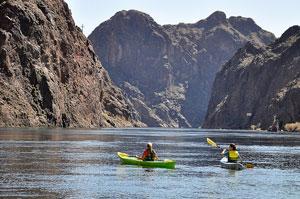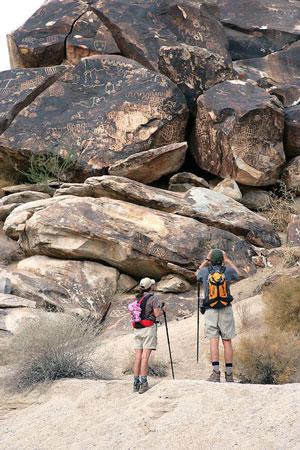Lake Mead National Recreation Area has just released a set of six maps that describe "self-guided adventures that range from quick trips by car, to peaceful raft trips down the river to a four-wheel-drive backcountry trip to Lake Mead." What makes these maps unique is the fact they're being used to promote some of the park's nine wilderness areas.
Those who understand that designated wilderness doesn't allow motorized travel or even bicycles may be a bit puzzled when a park spokesperson notes, "When people think of wilderness, they seldom think of houseboats, cars or four-wheelers, but at Lake Mead National Recreation Area, there is a way for visitors to experience the park's wilderness areas using all of these modes of transportation."
Is there a disconnect here?
Well, no, but those who read the recent press release about these trips need to be sure to read the whole thing. Here's the important qualifier:
"Lake Mead is home to nine wilderness areas, all located in Nevada. They were designated in 2002 to preserve the undeveloped land, so each one retains its primitive character and influence. Part of that designation means that motorized vehicles and bicycles aren't allowed in the wilderness areas."
Roads Lead to the Edges of Several Wilderness Areas in the Park
The park's approach is to point out that it can be pretty easy to reach the edges of some of these wilderness areas; from that point visitors can either just enjoy the view or take hikes'short and easy or longer and more challenging'into the wilderness areas themselves.
According to the press release, "Fortunately for enthusiasts who appreciate nature and a good four-wheel-drive experience or the comforts of home, most of Lake Mead NRA's wilderness areas are bordered by roads and waterways where the restrictions [on motorized vehicles or bicycles] don't apply."

The Black Canyon Water Trail offers access by kayak or other watercraft to the Black Canyon and Eldorado wilderness areas. NPS photo.
'We want people to explore these wilderness areas in ways that they like to recreate. We just ask that they do so respectfully, so that others may have similar experiences,' said Christie Vanover, park spokesperson.
New Maps Offer Tips for Six "Self-Guided Adventures" at Lake Mead NRA
To that end, the park has released a set of maps describing "six self-guided adventures" that take visitors adjacent to, or into, the park's wilderness areas; all locations are "just one to two hours from Las Vegas."
"Each Explore Map highlights a wilderness area in the park and describes what makes it unique, including its flora, fauna and geologic features. The maps also include seven 'Leave No Trace' principles as guidelines to help protect the resource."
Lake Mead is clearly best-known for its water-based recreation, so what might visitors find if they venture into the park's wilderness areas? Those who've never ventured away from the shoreline, or off the main roads, would probably be surprised, and this desert park does have plenty to offer beyond boating and waterskiing.
Here's a summary from the park staff of the trips covered by the new Explore Maps, and the wilderness areas that can be accessed via each trip:
Redstone is located just off Northshore Road at mile marker 27. People can drive straight to the attractive picnic area, then park and hike the easy half-mile trail or climb among the red sandstone outcroppings and ancient lava flows. The picnic area is adjacent to the Pinto Valley Wilderness Area.
'Redstone is our mini-version of Red Rock Canyon or Valley of Fire,' said Vanover. 'The stunning pop of red geology is a ruby in the desert.'
Just north of Redstone, at mile marker 30 along Northshore Road, is Boathouse Cove Road. This 9.1-mile backcountry road is not designated as wilderness, but it runs between the Jimbilnan Wilderness Area and the Pinto Valley Wilderness Area and leads to Lake Mead. There are two primitive campsites along the route. The first mile of the unpaved road has small rocks and is easily accessible with a high-clearance vehicle, but after that, staffers warn, the rocks turn to boulders and four-wheel-drive is needed.
Reaching the Wilderness Via the Water
Watercraft, including houseboats, provide access to the margins of the Pinto Valley, Jimbilnan, Eldorado, Iriteba & Spirit Mountain Wilderness areas.
According to a park spokesperson, "For those who prefer the comforts of home like satellite TV, a full kitchen, hot tubs and a soft bed, Forever Resorts rents houseboats on both Lake Mead and Lake Mohave. Renters can observe the wilderness views along the Nevada shorelines, or they can pull the boat up to a beach and take a hike for the day."
Yet another way to experience the wilderness by water is along the Black Canyon Water Trail. "Visitors can bring their own paddle craft or rent one from an authorized outfitter. Permitted businesses also offer guided raft, canoe and kayak trips from the base of the Hoover Dam down the river."
The final two Explore Maps describe areas that are located in the park's Mohave District (along Lake Mohave, the "other" lake in Lake Mead National Recreation Area) and offer a unique a look into the area's human history.

A short hike into Grapevine Canyon, in the Bridge Canyon Wilderness, offers views of petroglyphs. NPS photo.
Two Trips Near the Southern End of Lake Mohave
At Grapevine Canyon, in the Bridge Canyon Wilderness, visitors can walk a short distance from the parking area to see petroglyphs etched into large boulders. At Pipe Spring, visitors can park at the end of the road and hike through granite and metamorphic rock that is about 1.5 billion years old.
'Both of these areas play a prominent role in the religion and mythology of the Yuman tribes of the lower Colorado River, so like all areas of the park, we ask that you enjoy these rare sites with respect,' said Vanover.
Grapevine Canyon and Pipe Spring should be accessed from the south off Highway 163. They are also accessible from US 93, but that route has been damaged by recent storms and requires a four-wheel-drive high-clearance vehicle.
Some of these wilderness areas extend beyond the park boundary, and are jointly managed with the Bureau of Land Management. You can download all of the Explore Maps at this link on the park's website, and more information about Lake Mead National Recreation Area's nine wilderness areas and the 50th anniversary of the Wilderness Act is available here.
Want a preview of what's available in these oft-overlooked parts of the park? The following short video offers a nice sample of the park's Muddy Mountains Wilderness.


 Support Essential Coverage of Essential Places
Support Essential Coverage of Essential Places







Comments
Thank you, Jim. To tell the truth, I had no idea these places existed. They will provide some wonderful cool weather expeditions when it's too cold in northern climes and not too hot in the south.
To "access" wilderness doesn't mean you have to stand within its boundaries. The preservation of viewscapes is an important reason for wilderness designations, and this doesn't involve people crossing a wilderness boundary.
rdm24 - You are exactly right :-)